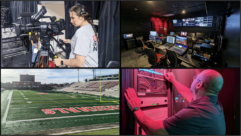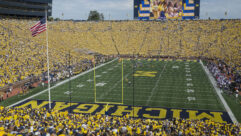
Installation Profile: Cornell University’s School of Civil and Environmental Engineering Instructional Facility
Mar 1, 2005 12:00 PM,
By Daniel Keller
Making the Earth move for science.
Control area at the Richard N. White Instructional Facility at Cornell University features a Crestron Isys touchpanel along with a Polycom VoiceStation and Dukane document camera.
While life-changing events such as the recent tsunami disaster tend to momentarily raise public awareness about earthquake studies, it’s reassuring to know that for a dedicated group of scientists and researchers, seismic research is a constant and ongoing pursuit. The George E. Brown Jr. Network for Earthquake Engineering Simulation (NEES) is a consortium of researchers seeking to lessen the impact of earthquake- and tsunami-related disasters by providing advanced capabilities for earthquake engineering research. The NEES Consortium has created a network of world-class laboratories around the United States, linked by a state-of-the-art communications network, making it possible for researchers to collaborate remotely on experiments, computational modeling, and education.
The NEES facility at Ithaca’s Cornell University is one of 15 research laboratories funded by the United States’ National Science Foundation (NSF) for experimental earthquake engineering research. The Cornell laboratory is unique among the NEES facilities, a mammoth industrial structure housed in the George Winter High Bay, a massive testing lab created to simulate tectonic shifts to study the effects of large-scale ground movement on underground infrastructure lifelines, such as gas, water, electrical, and communications systems. Strategically situated video cameras provide for detailed visual analysis of the testing procedures and results.
The School of Civil and Environmental Engineering (CEE) recently completed the Richard N. White Instructional Facility, a classroom and demonstration facility, constructed directly adjacent to the high bay to support instruction, testing, presentations, and videoconferencing with other NEES facilities, including multiple camera displays of the large-scale experiments performed within the facility. The classroom is designed with a glass wall — storefront style — to underscore its unique proximity to the adjacent research lab. The design creates an innovative, comfortable presentation space, offering a front-row view to the high baylab’s large-scale experiments, intercommunication with other NEES facilities, and a realtime teaching environment for in-class small-scale testing.
THE BIG PICTURE
An important objective for CEE in designing the new instructional facility was to create an AV system that would meet the organization’s unique presentation needs, complementing the major technological advancements in seismic study that the NEES project would be bringing to the table. To that end, the CEE and NEES team was very receptive to some of the new video presentation technologies.
The NEES system is designed to accommodate a matrix from one to an infinite number of cameras dedicated to close-up observation of the facility’s research procedures. The system presently uses four Sony PTZ (Pan/Tilt/Zoom) cameras, which feed a standalone “TelePresence” server, which is enabled by the NEESGrid. The cameras are also linked into a web page provided by the NEES integration team that is offered to the public for observation of the experiments and operations in the high bay.
“We were looking for a way to integrate the particular features of the NEES teleconferencing system with a standard video teleconferencing system, to create a single, integrated system,” explains David Ash, NEES/CEE IT specialist. “In addition to supporting PC, DVD, VHS, and other conventional instructional media, our goal was to integrate the feed from the NEES cameras into the teleconferencing projection system, so that researchers could view those cameras from within the classroom or from somewhere outside the campus and participate in video teleconferencing at the same time.”
Using a Christie LW25U native WXGA data/video projector and Crestron C2N-DVP4DI external image processor, the system can project a standard 1024×768 PC desktop image onto the 16:9 display, as well as dynamically displaying several live camera shots. A Crestron Isys TPS-5000 touchpanel allows the user to switch room modes, selecting live videoconferencing mode with split-screen video or a collaboration mode showing a large, left-justified PC image with smaller local and remote video windows tiled on the right of the screen. Another available image mode displays all research camera angles from the high bay, with one primary image shown larger than the other three. Using the touchpanel, the user can select any of the cameras as the primary image. The display space is intelligently mapped for maximum efficiency based on the selected viewing mode. This unique approach eliminates the need for a second display and allows all media to be input through a single lens. Because the screen and image are sized for this aspect ratio and resolution, the system also provides for future wide aspect HDTV content, without it having to be compressed to fit a 4:3 screen ratio.
“Once we were given the program requirements from CEE and NEES for the system, it became pretty clear that wide-screen image processing would be a very good fit for this room,” says Greg Bronson, Cornell’s facilities project leader. “Being able to fit more data on a single screen was far better than looking at multiple displays. Utilizing the Crestron multi-image processor and native widescreen mode, we were able to get more content onto a single display. Some in the industry have been starting to refer to this as ‘picture-outside-of-picture’ technology. It works well because when we get into teleconferencing, we can show a native, full display of the content. For example, we may be showing a PowerPoint or displaying the readings of one of the instrumentation panels, and then on the side we can display one or several talking heads. Everyone gets the same image at the same time. If you were to do that using a standard display, you would end up with picture-in-picture, which would mean that at least part of the primary image would be blocked by the smaller insert picture.”

The high bay earthquake testing lab is visible from the Richard N. White Instructional Facility. The conditions of the lab made wireless systems a sensible choice.
Compatibility with the rest of the system was also a challenge. “It was clear we needed to make sure that the presentation technology would support the school’s teaching needs and be compliant with that of the other NEES facilities throughout the United States, thereby allowing all the NEES researchers to collaborate and share research information,” says Bronson. “Specifically, in sharing that data, the NEES streaming function allows them to utilize video along with the data. So if you’re a researcher here at Cornell, and you’re running part of an experiment in California, you can see the data in realtime as well as using the cameras to see the visuals.”
MAKING THE PIECES FIT
Another logistical challenge was finding a way to successfully integrate the high bay and classroom — two somewhat disparate spaces. “The testing facility itself is a very industrial environment,” says Dan Forlenza, Cornell’s architect/design section leader. “It’s an earthquake testing chamber, and as such, it’s essentially a high-tech warehouse with forklifts driving around and a very high noise level. The challenge was to design the classroom as an integrated part of the testing facility but to isolate it enough that it wouldn’t be disrupted by the noise levels.”
The infrastructure was planned and installed by Cornell University staff, primarily members of CEE, the Planning, Design, and Construction and Information Technologies groups. The installation phase went smoothly, thanks in part to careful preplanning between sales, engineering, and installation personnel from Audio Video Corporation. AVC also provided system demonstration, operational training, and technical overview to the users and Cornell’s Classroom Technologies staff.
The building itself is roughly 1940s vintage, so it presented a few logistical challenges of its own. “For me as a technology designer, one of the more basic challenges was that the classroom was being built within a facility that had been designed specifically for Cornell’s earthquake research, so there was some special construction that had been employed in the building,” says Greg Bronson, “For example, we couldn’t trench the floor to run conduit because there was concern that it might have an impact on the structural integrity of the building’s specially designed foundation. So we had to look at alternatives for wiring the students’ and podium microphones.” Shure UC series systems were specified, using a Shure MX692 wireless table microphone and UC14/85 wireless lapel microphones.
“We realized immediately that we could make lemonade out of lemons by employing additional wireless technology, including wireless keyboards and wireless video. This not only got around the conduit issue, it also gave us a good bit more flexibility,” says Bronson.

The Crestron system is compatible with the other NEES facilities throughout the United States, allowing all the NEES researchers to collaborate and share research information.
The new system allows researchers quickly to get an eye-level view of experiments by rolling a self-contained Anthro video cart — equipped with a Clear-One FlexCam gooseneck camera and 910-171-382 wireless AV transmitter and Marshall Electronics V-R44P LCD monitor, all powered by a 12VDC gel cell — into the high bay area.
“From the technology side, one of the biggest variables was that one of the NEES cameras was wireless,” says Bronson. “When talking to the researchers during the planning stages, one thing that kept coming to my mind was that it might be of particular value to have a camera at eye-level that could be deployed quickly out of the research area. That was the catalyst for using this wireless camera technology. It was a bit of a challenge, though, in that the 2.4GHz spectrum is not a closed frequency and is subject to interference. It was of particular concern because one of our wireless data terminals had been relocated as part of the project and was now in close proximity to this camera. So I got together with the on-campus wireless data engineer, and we ended up moving the two devices to opposite ends of the spectrum, which eliminated most of the problem.”
DOUBLE DUTY
The high bay hosts three existing Sony EVI-D30 PTZ (Pan/Tilt/Zoom) cameras: One more EVI-D70 PTZ camera was installed in the high bay, as well as another two for classroom use. The facility’s roughly 40ft.-high ceiling allows the cameras to be mounted between 20ft. and 30ft. from the sources, using standard and digital zoom modes for close observation.

For the high bay, an Anthro video cart is equipped with a ClearOne FlexCam gooseneck camera and wireless AV transmitter and Marshall Electronics LCD monitor.
“Each camera goes to its own dedicated web server/streamer,” says Ash. “In order to bring it into the classroom, we ended up using a composite feed right into the video routers from all the cameras. In the high bay area, each camera is doing two things: It’s feeding the dedicated server for the NEES system and also feeding as a video source into the AV system, including a Polycom 9000 VP codec. This already proved to be an advantage during the ribbon-cutting ceremony, since we were able to videoconference through the new system to the NSF headquarters in Washington and very easily bring in all the different cameras during the conference.”
The NEES and NSF committees and CEE are reportedly very pleased with the new system’s capabilities. “Although a lot of what we were doing was based on untested technology, we’d done a significant amount of preplanning, and had already done some similar types of projects elsewhere on campus. We felt quite confident in our design,” says Bronson. “In fact, things went relatively smoothly, and everyone is quite happy with the system.”
For More Information
Anthro
www.anthro.com
Audio Video Corporation
www.audiovideocorp.com/
Christie
www.christiedigital.com
ClearOne
www.clearone.com
Crestron
www.crestron.com
Dukane
www.dukcorp.com
Marshall Electronics
www.mars-cam.com
National Science Foundation
www.nsf.gov/
NEES Consortium
www.nees.org/index.php
Polycom
www.polycom.com
Shure
www.shure.com










